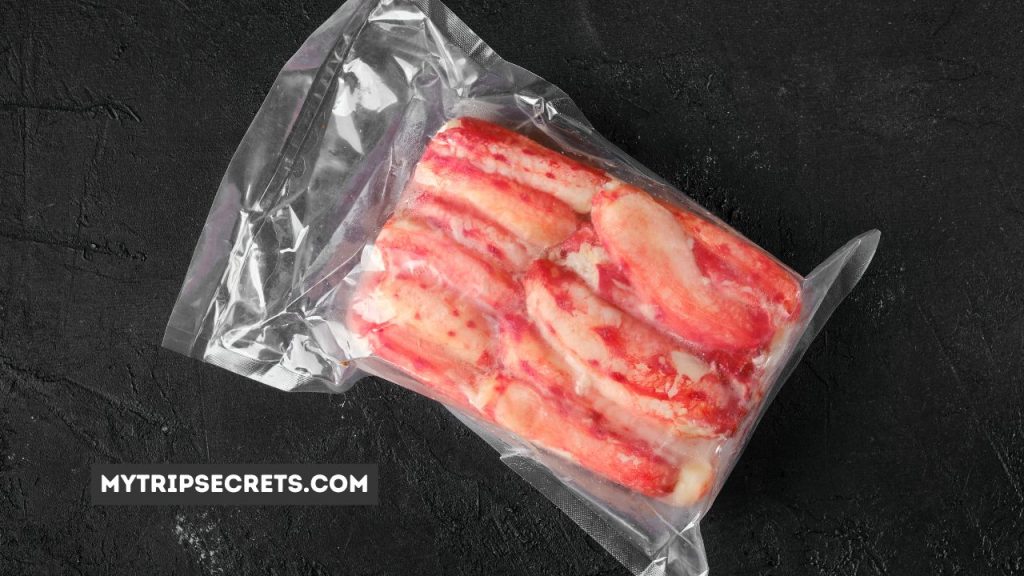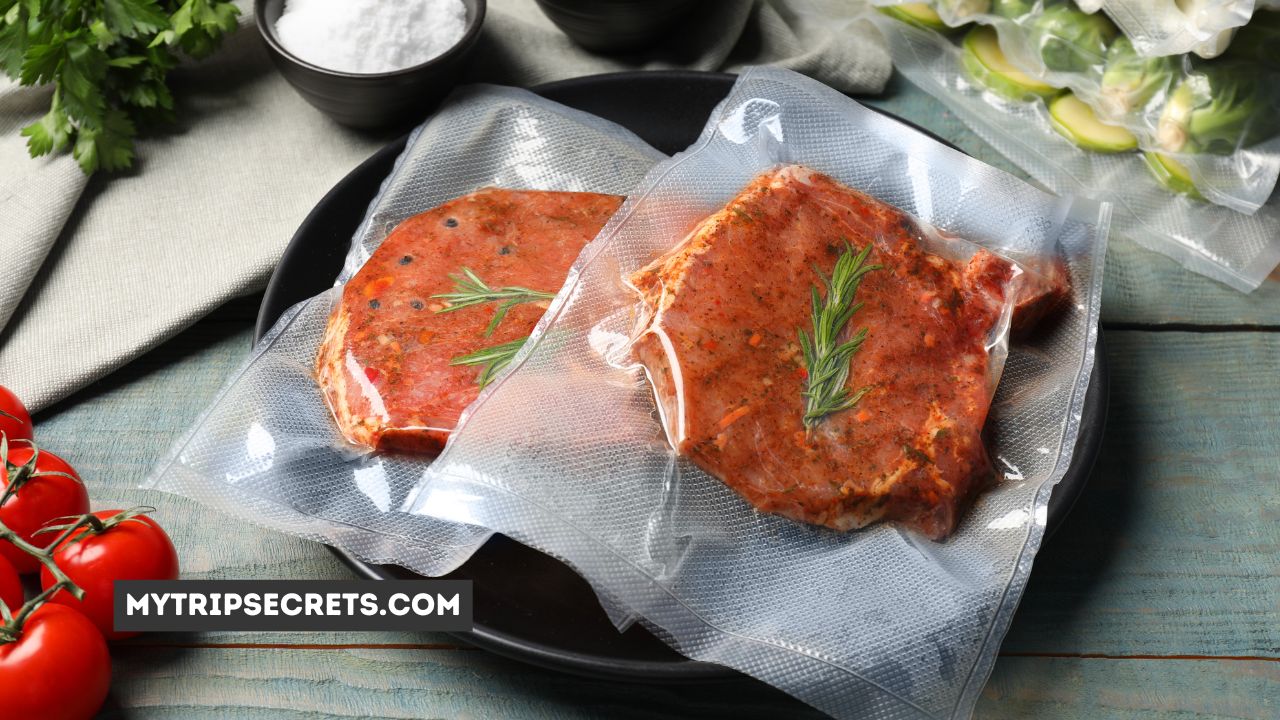Hunters, ardent carnivores, and foodies may want to bring meat on a plane. Due to rigorous safety standards and screening processes for perishable items, flying meat requires careful preparation. Our extensive guide explains on how to pack meat for air travel and what the TSA and other international security regulations need for transporting meat in checked and carry-on bags. Follow expert advice on insulating equipment, ice substitutes, and staggered freezing to maintain freshness.
We will discuss the types of meat allowed, quantity allowances, and paperwork needed when checking meat with commercial flights vs. chartered carriers locally and internationally. Includes critical information for decreasing inspection interruption risks in the worst-case scenario. So read on to become a savvy air travel “carnivore” ready to cruise through checkpoints and arrivals with delicious, flawlessly frozen meat cargo in tow – no matter your exciting globetrotting final destination!
Contents
- 1 How to Pack Meat for Air Travel
- 1.1 Hard-Sided Coolers
- 1.2 Reusable Ice Pack Alternatives
- 1.3 Insulating Wrap
- 1.4 Digital Thermometers
- 1.5 Absorbent Padding
- 1.6 Partially Freeze Before Packing
- 1.7 Segment Large Volumes
- 1.8 Repeat Insulating Layers
- 1.9 Position Ice Packs Properly
- 1.10 Permitted Meat Types
- 1.11 Quantity Allowances
- 1.12 Mandatory Declaration
- 1.13 Supporting Documentation
- 1.14 Navigating Inspections and Reaching Resolutions
- 1.15 Politely Comply
- 1.16 Have Proper Paperwork Accessible
- 1.17 Demonstrate Insulation Integrity
- 1.18 Request Discretion
- 1.19 Seek Supervisor Guidance
- 2 How much meat can you take on a plane?
- 3 Frequently Asked Questions
- 4 Conclusion
How to Pack Meat for Air Travel
Transporting raw meat on aircrafts necessitates investing in specialty equipment and leveraging insulating techniques that lock in freshness and prevent thawing despite pressure and temperature changes in flight. Consider the following gear:
Hard-Sided Coolers
Use rigid, waterproof thermoplastic cases with at least 2 inch walls versus cheaper foam versions for most durable freezing protection. Sturdy wheels and drag handles ease portability.
Reusable Ice Pack Alternatives
Commercial airline restrictions now ban loose ice, so reuse gel packs, dry ice or freezer blocks that meet carry on limits instead. Condition to -4°F for long hauls.
Insulating Wrap
Envelope meat cuts completely using multiple layers of insulating foam,reflective barrier sheets and bubble wrap to prevent freezer burn.
Digital Thermometers
Monitor interior conditions using wireless thermometers with exterior displays and temperature change alerts. This allows promptly intervening if readings fluctuate oddly.
Absorbent Padding
Line cooler bottoms with absorbent pads that contain leakage from meat packages. Discard any tainted padding immediately per regulations.
Now that you’re equipped with the best supplies possible, adhere to these evidence-backed techniques for optimizing meat freshness from airport to hotel:
Partially Freeze Before Packing
Chill meat to below 26°F initially so the freezing process continues gradually in transit versus risking unsafe partial thawing if packed fully frozen already.
Segment Large Volumes
Separate larger volumes of meat across a few smaller coolers to prevent overly dense stacking that inhibits sustained freezing.
Repeat Insulating Layers
Wrap meats in wax paper first, then foil, bubble wrap and finally insulation panels secured using freezer tape to create multiple air gap barriers impeding warmth.
Position Ice Packs Properly
Strategically place chilled ice substitutes directly beside and above/below meat items for most effective temperature stabilizing proximity rather than randomly scattering them.
Follow those packing best practices religiously to take your precious frozen meat cargo the distance intact!
Regulations and Restrictions Around Transporting Meat
While essential for spoilage prevention during lengthy transits, lugging meat does risks scrutiny and confiscation if regulations and red tape aren’t respected. So know these key airline and customs rules to avoid hassles:
Permitted Meat Types
Only commercially packaged beef, poultry, pork, lamb, venison cuts are transportable. Home packaged game meats require USDA inspection approval first for entry. Offal organ meats are universally prohibited.
Quantity Allowances
There are no TSA or customs limits on meat quantities in checked baggage but expect enhanced inspection above 50 lbs total. Carry-ons with meat are restricted to 5 lbs max.
Mandatory Declaration
Meat items must be voluntarily declared on customs declaration forms when crossing international borders or face penalties if later found. This includes duty fees for meat values exceeding allowable gift exemptions.
Supporting Documentation
Have all applicable hunting permits, USDA certificates and receipts proving legal purchase of meat for official review upon request. Commercial packaging labels should detail processing sources as well.
While rules predominantly focus on hoofed livestock meats permitted, always check details with both your airline and destination country embassy when considering bringing more obscure protein types like wild game overseas. Regulations fluctuate dynamically these days, so confirm specifics close to intended travel dates for most current compliance needs.
Now that your legal bases are covered, it’s also essential being prepared if questioned during security.
Despite best intentions declaring items, mandatory meat inspections do occasionally happen during airport screening if agents deem contents suspicious. If selected, follow these expert tips for smoothly facilitating examination:
Politely Comply
Calmly cooperate with any requests to unpack coolers for swab tests, manual searches or x-ray scans after initially declaring transported meat items. Any resistance Only escalates unnecessary drama.
Have Proper Paperwork Accessible
Keep all documentation validating legal procurement of meat together ready for immediate presentation if compliance red flags appear. Never assume you’ll breeze through unchecked.
Demonstrate Insulation Integrity
Respectfully highlight solid construction and expert insulating techniques used that maintain safe temperatures if agents express any temperature concerns during inspection. Offering to digitally show interior readings reassures.
Request Discretion
Politely ask for a private screening area if needing to fully unpack meat in crowded checkpoints so as to not disturb other passengers. This may not always be granted but can’t hurt requesting.
Seek Supervisor Guidance
If disagreements about regulations or confiscation threats arise, immediately request polite guidance from airline/TSA supervisors on next best steps before frustration boils over.
While worst case scenarios of surrendering treasured meat cuts remain possible despite best precautions, following the above conflict diffusion tips keeps situations from escalating further at busy travel hubs. Don’t let temporary losses ruin whole adventures ahead!
How much meat can you take on a plane?

For travellers wanting to transport treasured meat items as airline cargo, significant confusion exists around exactly how much is permitted before excess quantity crackdowns occur. Between vague policy terminology across carriers and inconsistently enforced limits once airborne, it’s difficult determining clear allowable thresholds – especially on international routes.
So what exactly constitutes reasonable volumes for flying with meat hassle-free both domestically and abroad? Read on for expert insights, real-world data points and preparatory tips that protect your precious packed protein from point A to B intact.
TSA Quantity Allowances According to official TSA guidance for US airport security screening:
“Meat, seafood and other non-liquid food items are permitted in both carry-on and checked bags with no standard TSA limitations enforced on quantities.”
This indicates flexibility transporting sizable quantities like multiple whole rib roasts or an entire smoked salmon in checked baggage across state lines with little scrutiny. Even sizable coolers brimming with meat cuts should technically pass if otherwise regulatory compliant. However the key consideration remains.
Practical Weight Limits
The above TSA allowance assumes travelers respect normal airline checked baggage weight thresholds before overload fees kick in – usually 50 lbs total. Hefting around morbidly obese suitcases bloated purely with meat products raises visibility.
So while no literal ceiling caps meat volumes in your bags, sticking within regular weight limits helps avoid unwanted inspections that often disrupt carefully packed freezing methods. Consider these real-world examples of quantities that passed scrutiny-free:
Carry On Cooler
- 5-10 lbs meat max
Checked Hard-Sided Cooler
- 20-30 lbs meat max
Large Checked Duffel/Suitcase Combo
- 15 lbs meat in one
- 30 lbs clothes/gear in another
Supplementing meat pounds with regular clothing/footwear distracts scans from solely focusing on your packed protein!
International Travel Considerations
Finally, while TSA oversight governs domestic legs of journeys, also research if destination countries specify any limitations regarding incoming meat products at customs declarations.
For example, Australia and New Zealand categorize any meat quantities exceeding 2.2 lbs as “commercial” requiring extra paperwork from ministry officials. Some African regions still prohibit incoming meats altogether over disease concerns too. Confirm specifics through embassy travel advisories beforehand to avoid disappointing losses!
Overwhelmingly, current guidance allows transporting meat in ample (if not gluttonous!) volumes if usual luggage weight limits are respected. But avoid baiting scrutiny carrying conspicuously obese parcels purely packed wall-to-wall with proteins! Supplementing with regular clothing helps too. Most importantly, always double check destination country specific importation procedures before assumption – policies continue evolving in our globally conscious world.
Frequently Asked Questions
Can meat stay frozen sufficiently in carry on bags alone during longer flights?
Rarely – the average airline cabin only maintains temperatures around 55°F, far too warm to reliably keep meat frozen solid for longer than 2 hours maximum. Checking cooler containers holding meat is truly the only flight method preventing unsafe partial thawing in transit.
What if ice packs leak and contaminate meat?
Immediately isolate any meat exposed to tainted meltwater runoff using air tight plastic bags. Report the spill incident to customs upon landing and dispose of the meat if advised instead of risking consumption. Never attempt rinsing off meat as this risks splash contamination.
Is it illegal hiding meat from airport security?
While no one relishes inspections, yes – intentionally concealing food items like meat or lying about contents when directly questioned during screening counts legally as smuggling with stiff penalties. Honest declaration during check in prevents awkward discoveries later.
Can dry ice be used to pack meat instead of gel packs?
Yes, with some constraints – airlines restrict carry on dry ice to 5.5 lbs and checked dry ice to 11 lbs before status switches to dangerous hazardous materials requiring specialized handling. So know weight capacities in advance when substituting dry ice for regular gel packs.
What if cooler seals fail causing meat spoilage?
If post-flight meat shows clear signs of spoilage like rancid odors, discoloration or unexpected soft textures, safely discard it entirely using secure biohazard bags. Never risk consuming foods potentially harboring harmful bacteria after breaks in the insured cold chain supply line.
Conclusion
As long as passengers adhere to all baggage restrictions and regulations, transporting meat by air should be a breeze, as we hope this guide has demonstrated. The pleasure of trying regional BBQ specialties more than compensates for the additional coordination required over standard baggage.
Following the aforementioned preparation tips, no thrilling vacation spot is out of reach for serious meat eaters who wish to fly with flavor. Get your grill tongs ready for some delicious adventures ahead, free from the stress of worrying about whether or not your steaks will stay!

